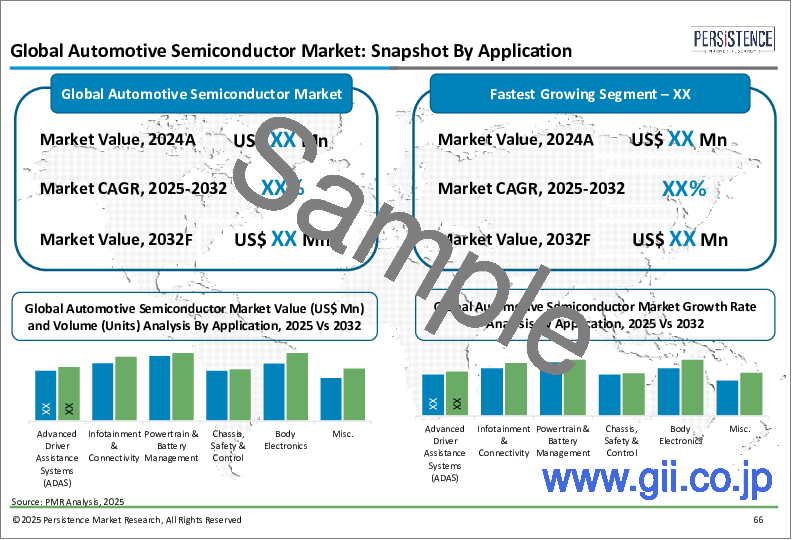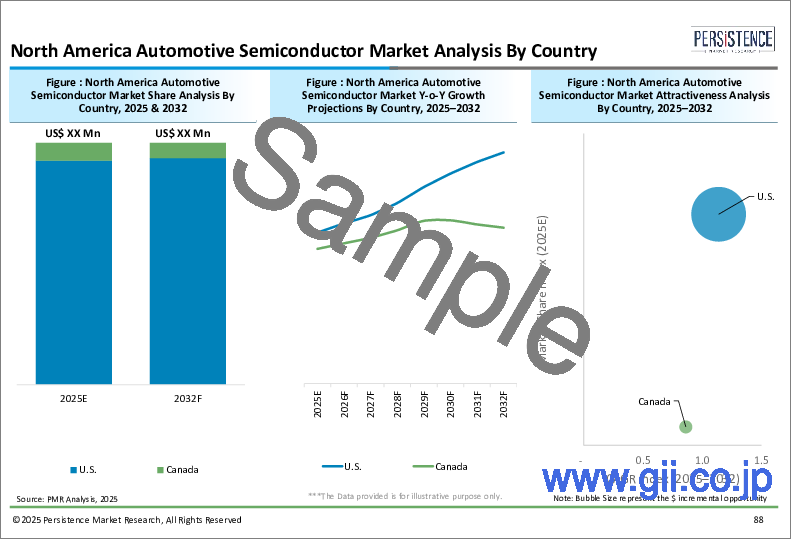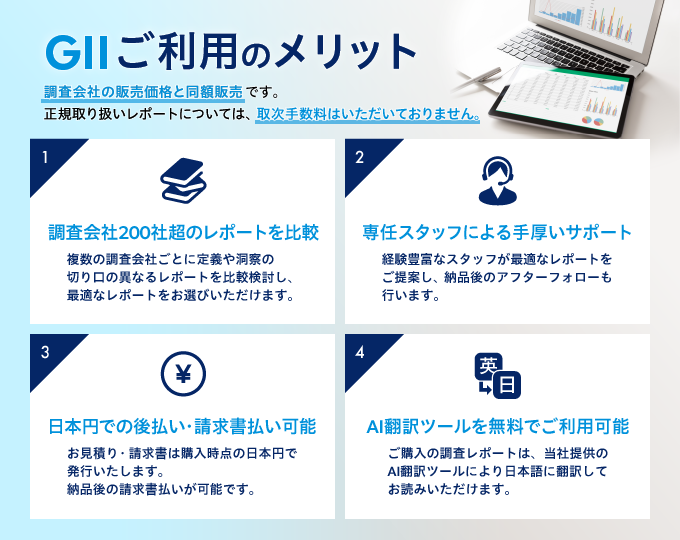|
|
市場調査レポート
商品コード
1631406
自動車用半導体の世界市場:業界分析、規模、シェア、成長、動向、予測(2025年~2032年)Automotive Semiconductor Market: Global Industry Analysis, Size, Share, Growth, Trends, and Forecast, 2025 - 2032 |
||||||
カスタマイズ可能
|
|||||||
| 自動車用半導体の世界市場:業界分析、規模、シェア、成長、動向、予測(2025年~2032年) |
|
出版日: 2025年01月08日
発行: Persistence Market Research
ページ情報: 英文 238 Pages
納期: 2~5営業日
|
全表示
- 概要
- 目次
世界の自動車用半導体の市場規模は、2025年に645億米ドルになるとみられ、2025年~2032年の予測期間に7.9%のCAGRで拡大し、2032年には1,098億米ドルに達すると予測されています。
自動車用半導体市場には、マイクロコントローラ、センサ、メモリデバイス、パワー半導体など、最新の自動車に使用される幅広い半導体コンポーネントが含まれます。これらのコンポーネントは、自動車の電動化、コネクティビティ、自律走行、安全強化などの高度な機能性を実現します。同市場は、乗用車、商用車、電気自動車など多様なセグメントに対応しています。ADAS(先進運転支援システム)の採用拡大、電気自動車(EV)の普及、車載システムへのIoTやAI技術の統合が成長の原動力となっています。
いくつかの主要な要因が世界の自動車用半導体市場を牽引しています。電気自動車やハイブリッド車に対する需要の高まりは、市場成長の大きな原動力となっています。これらの自動車は、バッテリー管理、パワートレイン制御、充電システム用に大量の半導体を必要とするからです。ADASと自律走行技術の急速な進歩により、高度なセンサー、プロセッサー、通信モジュールの使用が必要となります。さらに、燃費の改善と排出ガスの削減を義務付ける政府の厳しい規制が、自動車メーカーに半導体主導のソリューションを組み込むよう促しています。車載インフォテインメントやコネクティビティ・システムに対する消費者の需要が高まっていることも、市場拡大をさらに後押ししています。
自動車用半導体市場は、電気自動車と自律走行技術の採用拡大により、大きなビジネスチャンスをもたらしています。5GコネクティビティとVehicle-to-Everything(V2X)通信をサポートする半導体への需要が高まっています。3Dパッケージングやワイドバンドギャップ材料などの半導体製造プロセスの先進化は、技術革新の新たな道を開きます。新興市場への進出や、自動車メーカーとの協業によるオーダーメード・ソリューションが成長の道を開きます。さらに、自動車システムの持続可能性とエネルギー効率へのシフトは、パワーマネージメントとグリーンテクノロジーに焦点を当てた半導体のビジネスチャンスを生み出します。
当レポートでは、世界の自動車用半導体市場について調査し、コンポーネント別、車両タイプ別、用途別、地域別動向、および市場に参入する企業のプロファイルなどを提供しています。
目次
第1章 エグゼクティブサマリー
第2章 市場概要
- 市場の範囲と定義
- 市場力学
- コンポーネントライフサイクル分析
- 自動車用半導体市場:バリューチェーン
- ポーターファイブフォースの分析
- 地政学的緊張:市場への影響
- マクロ経済要因
- 予測要因- 関連性と影響
- 規制と技術の情勢
第3章 世界の自動車用半導体市場の見通し:実績(2019年~2024年)および予測(2025年~2032年)
- 主なハイライト
- 市場規模(10億米ドル)分析と予測
- 世界の自動車用半導体市場の見通し:コンポーネント別
- 市場の魅力分析:コンポーネント別
- 世界の自動車用半導体市場の見通し:車両タイプ別
- 市場の魅力分析:車両タイプ別
- 世界の自動車用半導体市場の見通し:用途別
- 市場の魅力分析:用途別
第4章 世界の自動車用半導体市場の見通し:地域別
- 主なハイライト
- 過去の市場規模(10億米ドル)と数量(個)の分析、2019年~2024年、地域別
- 現在の市場規模(10億米ドル)と数量(個)の予測、2025年~2032年、地域別
- 市場の魅力分析:地域別
第5章 北米の自動車用半導体市場の見通し:実績(2019年~2024年)と予測(2025年~2032年)
第6章 欧州の自動車用半導体市場の見通し:実績(2019年~2024年)および予測(2025年~2032年)
第7章 東アジアの自動車用半導体市場の見通し:実績(2019年~2024年)および予測(2025年~2032年)
第8章 南アジアおよびオセアニアの自動車用半導体市場の見通し:実績(2019年~2024年)および予測(2025年~2032年)
第9章 ラテンアメリカの自動車用半導体市場の見通し:実績(2019年~2024年)および予測(2025年~2032年)
第10章 中東・アフリカの自動車用半導体市場の見通し:実績(2019年~2024年)および予測(2025年~2032年)
第11章 競合情勢
- 市場シェア分析、2024年
- 市場構造
- 企業プロファイル(詳細- 概要、財務、戦略、最近の動向)
- Analog Devices, Inc.
- Infineon Technologies AG
- NXP Semiconductors
- Renesas Electronics Corporation
- Robert Bosch GmbH
- ROHM CO., LTD.
- Semiconductor Components Industries, LLC
- STMicroelectronics
- Texas Instruments Incorporated
- TOSHIBA CORPORATION
第12章 付録
Persistence Market Research has recently published an extensive report on the global Automotive Semiconductor Market. This report offers a comprehensive analysis of the key market dynamics, including drivers, trends, opportunities, and challenges, providing deep insights into the market structure.
Key Insights:
- Automotive Semiconductor Market Size (2025E): USD 64.5 Bn
- Projected Market Value (2032F): USD 109.8 Bn
- Global Market Growth Rate (CAGR 2025 to 2032): 7.9%
Automotive Semiconductor Market - Report Scope:
The Automotive Semiconductor Market encompasses a wide range of semiconductor components used in modern vehicles, such as microcontrollers, sensors, memory devices, and power semiconductors. These components enable advanced functionalities, including vehicle electrification, connectivity, autonomous driving, and safety enhancements. The market serves diverse segments, including passenger cars, commercial vehicles, and electric vehicles. Growth is driven by increasing adoption of advanced driver-assistance systems (ADAS), electric vehicle (EV) proliferation, and the integration of IoT and AI technologies in automotive systems.
Market Growth Drivers:
Several key factors are driving the global Automotive Semiconductor Market. The rising demand for electric and hybrid vehicles significantly fuels market growth, as these vehicles require a higher volume of semiconductors for battery management, powertrain control, and charging systems. The rapid advancements in ADAS and autonomous driving technologies necessitate the use of advanced sensors, processors, and communication modules. Additionally, stringent government regulations mandating improved fuel efficiency and reduced emissions push automakers to incorporate semiconductor-driven solutions. The increasing consumer demand for in-vehicle infotainment and connectivity systems further bolsters market expansion.
Market Restraints:
Despite promising growth prospects, the Automotive Semiconductor Market faces challenges related to supply chain disruptions and the global semiconductor shortage. High development costs and the complexity of integrating advanced semiconductor solutions into automotive systems can constrain market growth. Additionally, cybersecurity concerns and the need for robust data protection in connected and autonomous vehicles pose challenges. Competition from alternative technologies and regulatory hurdles also impact the pace of market expansion. Addressing these issues requires strategic partnerships, investment in R&D, and enhanced supply chain resilience.
Market Opportunities:
The Automotive Semiconductor Market presents significant opportunities driven by the growing adoption of electric vehicles and autonomous driving technologies. The demand for semiconductors supporting 5G connectivity and vehicle-to-everything (V2X) communication is rising. Advancements in semiconductor manufacturing processes, such as 3D packaging and wide-bandgap materials, open new avenues for innovation. Expansion into emerging markets and collaborations with automakers for tailored solutions provide avenues for growth. Additionally, the shift toward sustainability and energy efficiency in automotive systems creates opportunities for semiconductors focused on power management and green technologies.
Key Questions Answered in the Report:
- What are the primary factors driving the growth of the Automotive Semiconductor Market globally?
- Which semiconductor types and applications are leading in terms of adoption and sales?
- How are technological advancements influencing the competitive landscape of the Automotive Semiconductor Market?
- Who are the key players in the Automotive Semiconductor Market, and what strategies are they employing to remain competitive?
- What are the emerging trends and future prospects in the global Automotive Semiconductor Market?
Competitive Intelligence and Business Strategy:
Leading players in the global Automotive Semiconductor Market, including NXP Semiconductors, Infineon Technologies AG, and Texas Instruments, focus on innovation, product differentiation, and strategic partnerships to maintain a competitive edge. These companies invest in R&D to develop advanced semiconductor solutions addressing specific automotive requirements, such as ADAS, EV powertrains, and connectivity systems. Collaborations with automakers, Tier-1 suppliers, and technology firms facilitate market access and visibility. Emphasis on quality standards, cybersecurity measures, and targeted marketing campaigns enhances brand reputation and drives growth in the evolving Automotive Semiconductor Market landscape.
Key Companies Profiled:
- Analog Devices, Inc.
- Infineon Technologies AG
- NXP Semiconductors
- Renesas Electronics Corporation
- Robert Bosch GmbH
- ROHM CO., LTD.
- Semiconductor Components Industries, LLC
- STMicroelectronics
- Texas Instruments Incorporated
Automotive Semiconductor Market Research Segmentation
By Component Location:
- Processor
- Analog IC
- Sensor
- Memory
- Misc
By Vehicle Type:
- Passenger Car
- LCV
- HCV
By Application:
- Powertrain
- Safety
- Body Electronics
- Chassis
- Telematics and Infotainment
By Region:
- North America
- Europe
- East Asia
- South Asia & Oceania
- Latin America
- Middle East & Africa
Table of Contents
1. Executive Summary
- 1.1. Global Automotive Semiconductor Market Snapshot, 2025 - 2032
- 1.2. Market Opportunity Assessment, 2025 - 2032, US$ Bn
- 1.3. Key Market Trends
- 1.4. Future Market Projections
- 1.5. Premium Market Insights
- 1.6. Industry Developments and Key Market Events
- 1.7. PMR Analysis and Recommendations
2. Market Overview
- 2.1. Market Scope and Definition
- 2.2. Market Dynamics
- 2.2.1. Drivers
- 2.2.2. Restraints
- 2.2.3. Opportunity
- 2.2.4. Challenges
- 2.2.5. Key Trends
- 2.3. Component Lifecycle Analysis
- 2.4. Automotive Semiconductor Market: Value Chain
- 2.4.1. List of Raw Material Supplier
- 2.4.2. List of Manufacturers
- 2.4.3. List of Distributors
- 2.4.4. List of Applications
- 2.4.5. Profitability Analysis
- 2.5. Porter Five Force's Analysis
- 2.6. Geopolitical Tensions: Market Impact
- 2.7. Macro-Economic Factors
- 2.7.1. Global Sectorial Outlook
- 2.7.2. Global GDP Growth Outlook
- 2.7.3. Global Parent Market Overview
- 2.8. Forecast Factors - Relevance and Impact
- 2.9. Regulatory and Technology Landscape
3. Global Automotive Semiconductor Market Outlook: Historical (2019 - 2024) and Forecast (2025 - 2032)
- 3.1. Key Highlights
- 3.1.1. Market Volume (Units) Projections
- 3.1.2. Market Size and Y-o-Y Growth
- 3.1.3. Absolute $ Opportunity
- 3.2. Market Size (US$ Bn ) Analysis and Forecast
- 3.2.1. Historical Market Size Analysis, 2019 - 2024
- 3.2.2. Current Market Size Forecast, 2025 - 2032
- 3.3. Global Automotive Semiconductor Market Outlook: Component
- 3.3.1. Introduction / Key Findings
- 3.3.2. Historical Market Size (US$ Bn ) and Volume (Units) Analysis By Component, 2019 - 2024
- 3.3.3. Current Market Size (US$ Bn ) and Volume (Units) Forecast By Component, 2025 - 2032
- 3.3.3.1. Processor
- 3.3.3.2. Analog IC
- 3.3.3.3. Sensor HCV
- 3.3.3.4. Memory
- 3.3.3.5. Misc
- 3.4. Market Attractiveness Analysis: Component
- 3.5. Global Automotive Semiconductor Market Outlook: Vehicle Type
- 3.5.1. Introduction / Key Findings
- 3.5.2. Historical Market Size (US$ Bn ) and Volume (Units) Analysis By Vehicle Type, 2019 - 2024
- 3.5.3. Current Market Size (US$ Bn ) and Volume (Units) Forecast By Vehicle Type, 2025 - 2032
- 3.5.3.1. Passenger Car
- 3.5.3.2. LCV
- 3.5.3.3. HCV
- 3.6. Market Attractiveness Analysis: Vehicle Type
- 3.7. Global Automotive Semiconductor Market Outlook: Application
- 3.7.1. Introduction / Key Findings
- 3.7.2. Historical Market Size (US$ Bn ) and Volume (Units) Analysis By Application, 2019 - 2024
- 3.7.3. Current Market Size (US$ Bn ) and Volume (Units) Forecast By Application, 2025 - 2032
- 3.7.3.1. Powertrain
- 3.7.3.2. Safety
- 3.7.3.3. Body Electronics
- 3.7.3.4. Chassis
- 3.7.3.5. Telematics and Infotainment
- 3.8. Market Attractiveness Analysis: Application
4. Global Automotive Semiconductor Market Outlook: Region
- 4.1. Key Highlights
- 4.2. Historical Market Size (US$ Bn ) and Volume (Units) Analysis By Region, 2019 - 2024
- 4.3. Current Market Size (US$ Bn ) and Volume (Units) Forecast By Region, 2025 - 2032
- 4.3.1. North America
- 4.3.2. Europe
- 4.3.3. East Asia
- 4.3.4. South Asia and Oceania
- 4.3.5. Latin America
- 4.3.6. Middle East & Africa (MEA)
- 4.4. Market Attractiveness Analysis: Region
5. North America Automotive Semiconductor Market Outlook: Historical (2019 - 2024) and Forecast (2025 - 2032)
- 5.1. Key Highlights
- 5.2. Pricing Analysis
- 5.3. Historical Market Size (US$ Bn ) and Volume (Units) Analysis By Market, 2019 - 2024
- 5.3.1. By Country
- 5.3.2. By Component
- 5.3.3. By Vehicle Type
- 5.3.4. By Application
- 5.4. Current Market Size (US$ Bn ) and Volume (Units) Forecast By Country, 2025 - 2032
- 5.4.1. U.S.
- 5.4.2. Canada
- 5.5. Current Market Size (US$ Bn ) and Volume (Units) Forecast By Component, 2025 - 2032
- 5.5.1. Processor
- 5.5.2. Analog IC
- 5.5.3. Sensor
- 5.5.4. Memory
- 5.5.5. Misc
- 5.6. Current Market Size (US$ Bn ) and Volume (Units) Forecast By Vehicle Type, 2025 - 2032
- 5.6.1. Passenger Car
- 5.6.2. LCV
- 5.6.3. HCV
- 5.7. Current Market Size (US$ Bn ) and Volume (Units) Forecast By Application, 2025 - 2032
- 5.7.1. Powertrain
- 5.7.2. Safety
- 5.7.3. Body Electronics
- 5.7.4. Chassis
- 5.7.5. Telematics and Infotainment
- 5.8. Market Attractiveness Analysis
6. Europe Automotive Semiconductor Market Outlook: Historical (2019 - 2024) and Forecast (2025 - 2032)
- 6.1. Key Highlights
- 6.2. Pricing Analysis
- 6.3. Historical Market Size (US$ Bn ) and Volume (Units) Analysis By Market, 2019 - 2024
- 6.3.1. By Country
- 6.3.2. By Component
- 6.3.3. By Vehicle Type
- 6.3.4. By Application
- 6.4. Current Market Size (US$ Bn ) and Volume (Units) Forecast By Country, 2025 - 2032
- 6.4.1. Germany
- 6.4.2. France
- 6.4.3. U.K.
- 6.4.4. Italy
- 6.4.5. Spain
- 6.4.6. Russia
- 6.4.7. Turkey
- 6.4.8. Rest of Europe
- 6.5. Current Market Size (US$ Bn ) and Volume (Units) Forecast By Component, 2025 - 2032
- 6.5.1. Processor
- 6.5.2. Analog IC
- 6.5.3. Sensor
- 6.5.4. Memory
- 6.5.5. Misc
- 6.6. Current Market Size (US$ Bn ) and Volume (Units) Forecast By Vehicle Type, 2025 - 2032
- 6.6.1. Passenger Car
- 6.6.2. LCV
- 6.6.3. HCV
- 6.7. Current Market Size (US$ Bn ) and Volume (Units) Forecast By Application, 2025 - 2032
- 6.7.1. Powertrain
- 6.7.2. Safety
- 6.7.3. Body Electronics
- 6.7.4. Chassis
- 6.7.5. Telematics and Infotainment
- 6.8. Market Attractiveness Analysis
7. East Asia Automotive Semiconductor Market Outlook: Historical (2019 - 2024) and Forecast (2025 - 2032)
- 7.1. Key Highlights
- 7.2. Pricing Analysis
- 7.3. Historical Market Size (US$ Bn ) and Volume (Units) Analysis By Market, 2019 - 2024
- 7.3.1. By Country
- 7.3.2. By Component
- 7.3.3. By Vehicle Type
- 7.3.4. By Application
- 7.4. Current Market Size (US$ Bn ) and Volume (Units) Forecast By Country, 2025 - 2032
- 7.4.1. China
- 7.4.2. Japan
- 7.4.3. South Korea
- 7.5. Current Market Size (US$ Bn ) and Volume (Units) Forecast By Component, 2025 - 2032
- 7.5.1. Processor
- 7.5.2. Analog IC
- 7.5.3. Sensor
- 7.5.4. Memory
- 7.5.5. Misc
- 7.6. Current Market Size (US$ Bn ) and Volume (Units) Forecast By Vehicle Type, 2025 - 2032
- 7.6.1. Passenger Car
- 7.6.2. LCV
- 7.6.3. HCV
- 7.7. Current Market Size (US$ Bn ) and Volume (Units) Forecast By Application, 2025 - 2032
- 7.7.1. Powertrain
- 7.7.2. Safety
- 7.7.3. Body Electronics
- 7.7.4. Chassis
- 7.7.5. Telematics and Infotainment
- 7.8. Market Attractiveness Analysis
8. South Asia & Oceania Automotive Semiconductor Market Outlook: Historical (2019 - 2024) and Forecast (2025 - 2032)
- 8.1. Key Highlights
- 8.2. Pricing Analysis
- 8.3. Historical Market Size (US$ Bn ) and Volume (Units) Analysis By Market, 2019 - 2024
- 8.3.1. By Country
- 8.3.2. By Component
- 8.3.3. By Vehicle Type
- 8.3.4. By Application
- 8.4. Current Market Size (US$ Bn ) and Volume (Units) Forecast By Country, 2025 - 2032
- 8.4.1. India
- 8.4.2. Southeast Asia
- 8.4.3. ANZ
- 8.4.4. Rest of South Asia & Oceania
- 8.5. Current Market Size (US$ Bn ) and Volume (Units) Forecast By Component, 2025 - 2032
- 8.5.1. Processor
- 8.5.2. Analog IC
- 8.5.3. Sensor
- 8.5.4. Memory
- 8.5.5. Misc
- 8.6. Current Market Size (US$ Bn ) and Volume (Units) Forecast By Vehicle Type, 2025 - 2032
- 8.6.1. Passenger Car
- 8.6.2. LCV
- 8.6.3. HCV
- 8.7. Current Market Size (US$ Bn ) and Volume (Units) Forecast By Application, 2025 - 2032
- 8.7.1. Powertrain
- 8.7.2. Safety
- 8.7.3. Body Electronics
- 8.7.4. Chassis
- 8.7.5. Telematics and Infotainment
- 8.8. Market Attractiveness Analysis
9. Latin America Automotive Semiconductor Market Outlook: Historical (2019 - 2024) and Forecast (2025 - 2032)
- 9.1. Key Highlights
- 9.2. Pricing Analysis
- 9.3. Historical Market Size (US$ Bn ) and Volume (Units) Analysis By Market, 2019 - 2024
- 9.3.1. By Country
- 9.3.2. By Component
- 9.3.3. By Vehicle Type
- 9.3.4. By Application
- 9.4. Current Market Size (US$ Bn ) and Volume (Units) Forecast By Country, 2025 - 2032
- 9.4.1. Brazil
- 9.4.2. Mexico
- 9.4.3. Rest of Latin America
- 9.5. Current Market Size (US$ Bn ) and Volume (Units) Forecast By Component, 2025 - 2032
- 9.5.1. Processor
- 9.5.2. Analog IC
- 9.5.3. Sensor
- 9.5.4. Memory
- 9.5.5. Misc
- 9.6. Current Market Size (US$ Bn ) and Volume (Units) Forecast By Vehicle Type, 2025 - 2032
- 9.6.1. Passenger Car
- 9.6.2. LCV
- 9.6.3. HCV
- 9.7. Current Market Size (US$ Bn ) and Volume (Units) Forecast By Application, 2025 - 2032
- 9.7.1. Powertrain
- 9.7.2. Safety
- 9.7.3. Body Electronics
- 9.7.4. Chassis
- 9.7.5. Telematics and Infotainment
- 9.8. Market Attractiveness Analysis
10. Middle East & Africa Automotive Semiconductor Market Outlook: Historical (2019 - 2024) and Forecast (2025 - 2032)
- 10.1. Key Highlights
- 10.2. Pricing Analysis
- 10.3. Historical Market Size (US$ Bn ) and Volume (Units) Analysis By Market, 2019 - 2024
- 10.3.1. By Country
- 10.3.2. By Component
- 10.3.3. By Vehicle Type
- 10.3.4. By Application
- 10.4. Current Market Size (US$ Bn ) and Volume (Units) Forecast By Country, 2025 - 2032
- 10.4.1. GCC
- 10.4.2. Egypt
- 10.4.3. South Africa
- 10.4.4. Northern Africa
- 10.4.5. Rest of Middle East & Africa
- 10.5. Current Market Size (US$ Bn ) and Volume (Units) Forecast By Component, 2025 - 2032
- 10.5.1. Processor
- 10.5.2. Analog IC
- 10.5.3. Sensor
- 10.5.4. Memory
- 10.5.5. Misc
- 10.6. Current Market Size (US$ Bn ) and Volume (Units) Forecast By Vehicle Type, 2025 - 2032
- 10.6.1. Passenger Car
- 10.6.2. LCV
- 10.6.3. HCV
- 10.7. Current Market Size (US$ Bn ) and Volume (Units) Forecast By Application, 2025 - 2032
- 10.7.1. Powertrain
- 10.7.2. Safety
- 10.7.3. Body Electronics
- 10.7.4. Chassis
- 10.7.5. Telematics and Infotainment
- 10.8. Market Attractiveness Analysis
11. Competition Landscape
- 11.1. Market Share Analysis, 2024
- 11.2. Market Structure
- 11.2.1. Competition Intensity Mapping By Market
- 11.2.2. Competition Analog IC
- 11.2.3. Apparent Product Capacity
- 11.3. Company Profiles (Details - Overview, Financials, Strategy, Recent Developments)
- 11.3.1. Analog Devices, Inc.
- 11.3.1.1. Overview
- 11.3.1.2. Segments and Product
- 11.3.1.3. Key Financials
- 11.3.1.4. Market Developments
- 11.3.1.5. Market Strategy
- 11.3.2. Infineon Technologies AG
- 11.3.2.1. Overview
- 11.3.2.2. Segments and Product
- 11.3.2.3. Key Financials
- 11.3.2.4. Market Developments
- 11.3.2.5. Market Strategy
- 11.3.3. NXP Semiconductors
- 11.3.3.1. Overview
- 11.3.3.2. Segments and Product
- 11.3.3.3. Key Financials
- 11.3.3.4. Market Developments
- 11.3.3.5. Market Strategy
- 11.3.4. Renesas Electronics Corporation
- 11.3.4.1. Overview
- 11.3.4.2. Segments and Product
- 11.3.4.3. Key Financials
- 11.3.4.4. Market Developments
- 11.3.4.5. Market Strategy
- 11.3.5. Robert Bosch GmbH
- 11.3.5.1. Overview
- 11.3.5.2. Segments and Product
- 11.3.5.3. Key Financials
- 11.3.5.4. Market Developments
- 11.3.5.5. Market Strategy
- 11.3.6. ROHM CO., LTD.
- 11.3.6.1. Overview
- 11.3.6.2. Segments and Product
- 11.3.6.3. Key Financials
- 11.3.6.4. Market Developments
- 11.3.6.5. Market Strategy
- 11.3.7. Semiconductor Components Industries, LLC
- 11.3.7.1. Overview
- 11.3.7.2. Segments and Product
- 11.3.7.3. Key Financials
- 11.3.7.4. Market Developments
- 11.3.7.5. Market Strategy
- 11.3.8. STMicroelectronics
- 11.3.8.1. Overview
- 11.3.8.2. Segments and Product
- 11.3.8.3. Key Financials
- 11.3.8.4. Market Developments
- 11.3.8.5. Market Strategy
- 11.3.9. Texas Instruments Incorporated
- 11.3.9.1. Overview
- 11.3.9.2. Segments and Product
- 11.3.9.3. Key Financials
- 11.3.9.4. Market Developments
- 11.3.9.5. Market Strategy
- 11.3.10. TOSHIBA CORPORATION
- 11.3.10.1. Overview
- 11.3.10.2. Segments and Product
- 11.3.10.3. Key Financials
- 11.3.10.4. Market Developments
- 11.3.10.5. Market Strategy
- 11.3.1. Analog Devices, Inc.
12. Appendix
- 12.1. Research Methodology
- 12.2. Research Assumptions
- 12.3. Acronyms and Abbreviations





